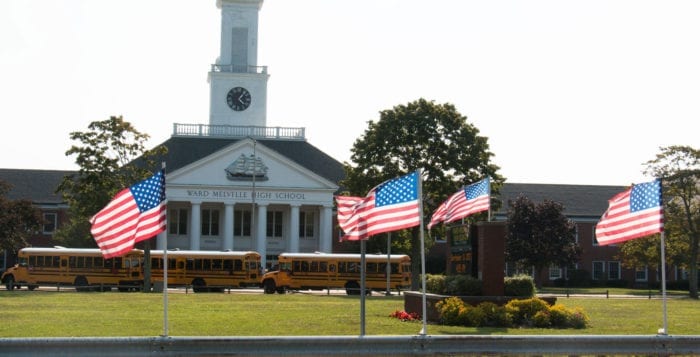By Andrea Paldy
As the Three Village Central School District continues to see a decline in its enrollment, it can look to the performance of its students as a bright spot on the district’s annual report card.
At the district’s mid-October school board meeting, Kevin Scanlon, assistant superintendent for educational services, presented a snapshot of the state of the district.
Enrollment continued to decline, dropping about 3 percent from last year, to 6,264 students. With well over 600 students, the current senior class is the largest in the district, Scanlon said.
During his presentation, Scanlon also went over the results of state assessment and Regents examinations. He called the Regents scores “amazing,” saying that they were some of the highest in the state. Ninety-seven percent of the students who took the Regents English Language Arts and U.S. History and Government exams passed, and 93 percent passed the Global History and Geography Regents exam, he said.
On the Common Core-aligned math Regents exams, 95 percent passed the Algebra exam, while Geometry had an 89 percent passing rate, and 99 percent passed the
Algebra II exam. Seventy-one percent of the smaller group who took the old Algebra 2/Trigonometry exam passed.
Equally as “amazing” were the results from the science Regents, Scanlon said. At least 91 percent of students taking the four science exams — Earth Science, Living Environment, Chemistry and Physics — passed, with the highest pass rate in Living Environment, at 97 percent.
Scanlon noted that Three Village students continue to perform above the state mean for SAT scores and had the highest scores for Suffolk County.
“I happen to attribute this to the students and the hard work of the teachers,” he said.
“All of the services that we’ve been putting into place are really coming to fruition.”
— Kevin Scanlon
He also pointed to the installation of the writing and math centers at all of the secondary schools.
“All of the services that we’ve been putting into place are really coming to fruition,” Scanlon said.
Additional numbers from the class of 2017 show a 96 percent graduation rate. The same percentage of students went on to two- and four-year colleges. The assistant superintendent also recognized the less than 1 percent of graduates who went directly into military service.
The report also covered the yearly state assessments for students in grades three through eight. Thirty-two percent of Three Village students took the English Language Arts (ELA) assessment — this is down 2 percent from the previous year. Additionally, 31 percent took the math assessment, which was up 1 percent from the previous year.
As in past years, Three Village students’ scores surpassed both the state and Nassau and Suffolk counties averages. The state average for the number of students who met or exceeded proficiency was 39.8 percent, while in Three Village, the number of students meeting or exceeding standards for each grade was 61 percent and above, Scanlon reported. In math, the state average was 40.2 percent. At least 73 percent of district test takers met or exceeded standards at each grade level, except in eighth grade. This was because the majority of district eighth-graders took the Algebra I Regents instead of the math assessment, Scanlon said.
He said that when compared to similar districts — Commack, Half Hollow Hills, Harborfields, Hauppauge, Northport, Port Jefferson and Smithtown — Three Village students outperformed those districts in all but two grades on the ELA and all but one grade in math.
Areas that the district continues to work on are elementary math and reading, Scanlon said. In addition to the Lucy Calkins Units of Study for writing, previously introduced to students in kindergarten through eighth grade, the district recently introduced Units of Study for reading, he said, because “literacy is the most important key” to all subjects. He added that students are tested three times throughout the year in both math and reading to get a baseline for their progress. This allows teachers to begin intervention even earlier than before, the assistant superintendent said.
The landscape continues to change with New York State’s introduction of the new Social Studies standards last year and the new science standards that are being rolled out this year for kindergarten through second grade, Scanlon explained.
In the next few years, he said, students can expect to see significant changes as the state continues to adjust to new standards.







